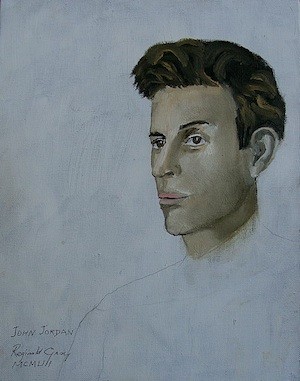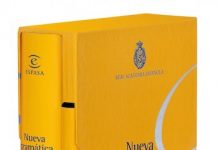Hoy, viernes 18 de octubre de 2013, se inaugura ISLA, Festival Literario de Dublin organizado por el Instituto Cervantes de la citada capital en el que participaran destacados esritores españoles, irlandeses y latinoamericanos, ocasión para la que rescatamos este artículo, en inglés, acerca de las relaciona literarias hispano-irlandesas publicado por John Jordan en 1985, en el semanario News Hibernia. Posiblemente sea el único artículo publicado en la prensa irlandesa acerca del citado tema.

IRELAND AND SPAIN – LITERARY LINKS
IT IS a commonplace that the Irish-Spanish connections is venerable and persistent, although one suspects that it barely surfaces in the consciousness of the Irish tourists who for the last quarter-century have been descending on the Costa Brava and the Costa del Sol. In this century alone the literature links are of surprising profusion and I propose for a month or two to consider some of them.
Any roll-call of Irish creative writers in the post-First World War period who have been touched by the Spanish experience must begin with Thomas MacGreevy (1893-1967) in whose single but import volume of verse, Poems (1934) is a poem celebrating a name to be found right across Spain: O’ Donnell. «Aodh Ruadh Ó Domhnaill» is MacGreevy’s impressionistic statement of his unsuccessful search in Valladolid for the tomb of the «Bright-haired young man», Red Hugh O’Donnell.
When MacGreevy’s slightly younger contemporary Liam O’Flaherty (1896-1984) published in 1953 his only book in Irish, Dúil, some were puzzled by the last story «Oifig an Phoist». Part of the wry comedy arises from the farcical process of transmitting a telegram via Galway City to a Spanish dancer in Los Angeles from a Connemara village.
The telegram consists of a quotation from Federico Garcia Lorca, and the postmaster fears that the text may be obscene. Outraged, the Spanish girl visitor disclaims Lorca before the locals, who are enchanted. This, I believe is a epiphany unique in Irish letters in either language.
From an internal reference to Korean War we know that the story was written close to the time of publication. But O’Flaherty’s Spanish experience went back to the early 1930s. In his autobiographical volume Shame the Devil (1934 and 1981) he tells how he came to Seville and finding there only noise and smells, fled to Madrid where he discovered the bullfight and spent two days in the Prado, looking chiefly at Goya. He then moved on to Toledo to look at El Greco, by whom he was back to London, surfeited with snails and wine, he has more interest to say about the City of the Kings than about Madrid or Seville.
He was not impressed by the re-naming ot a street after «Carlos Marx». «Marxism is something more important than a paint-brush in the hands of a nocturnal nasty-boy». The Cathedral disgusted him: «It smelt of death and starvation, even though it was crowded with priests and worshippers and within its walls was sufficient wealth to buy a city of considerable size. What a contrast to the poverty ot the citizens was presented by the magnificence ot its treasures! I was glad to leave it, for it made me angry, almost into agreeing with the men who had written the name of Carlos Marx on its rump.»
AUSTIN CLARKE
The Spanish experience of MacGreevy and O’Flaherty is peripheral to their lives and work. In the cases of two other writers of their generation Austin Clarke 81896-1974) and Kate O’Brien (1897-1994) it is peripheral to the life but not to the work of the first, and central to both the life and work ot the second. Clarke did not visit Spain until he was an old man, so far as I know, whereas O’Brien first went there (as a governess) when she was 24. The extraordinary coincidence that at an early age the name of the once great university town of Salamanca should have crept into the consciousness of both writers, suggest to me that they may be treated, at greater lenght, together, at a later date.
When he was already over 70, it may be traced back as far as 1919 when he was 23. The evidence for this is an odd little poem «In Kildare Street» published nearly half a century later in the volume The Echo at Coole (1968). Some time before April 1919 Clarke, the junior lecturer in English in UCD was making his way to the National Library when he passed the legendary Provost of Trinity College, J.P.Mahaffy (who died on April 30, 1919): he was struck by the contrast between his mute encounter with this venerable representative of cultured Anglo-Irish Ascendancy at its most colourful and intolerant, and his mission in the library. This was read (or re-read) The Great Magician, one ot the sacred dramas ot the great Spanish Counter-Reformation dramatist Calderon de la Barca (1600-81).
The year before The Echo, Clarke published his volume Old-Fashioned Pilgrimage containing verse impressions of recent visits to the USA, Yugoslavia, and Spain. The two Spanish poems are Fiesta in Spain and Garcia Lorca. The first ot these has one curious feature in the context of Clarke’s imaginative history: six cities in the south are mentioned, but in the north, only Madrid. One must surprised that he did not visit Salamanca, only a few hours from Madrid, for that is the city name that blazes like a jewel from the heart ot one of Clarke’s greatest poems «The Straying Student», collected in an early volume Night and Morning (1938) and in 1968 he published Two Interludes adapted from Cervantes.
The first of these brief comic playlets, The Student from Salamanca is more properly translated The Cave of Salamanca. Clarke´s «straying student» who has been «sent back from Salamanca» is a natural ascetic half-crazed by sexual temptation. The «student from Salamanca in the Cervantes piece is no ascetic, failed or otherwise, but a wandering scholar who helps a young wife deceive her gullible husband by staging «visions» supposed to have been conjured up from the legendary magical Cave of Salamanca.
KATE O’BRIEN
Although Kate O’Brien was familiar with Northern Spain from 1922 when she arrived in Bilbao to work as a governess, it was not until 1936, when she was already a successful novelist that she made use of her Spanish experience. Her first Spanish book, her third novel Mary Lavelle was followed, in 1937, by ther travel book Farewell Spain, a distillation of her Spanish memories from 1922 to 1936, just before the outbreak ot the Civil War.
On her last pre-war visit among the cities she had touched on was Salamanca. I do
not know exactly how early in life Austin Clarke became aware of the Cave of Salamanca and its magic. but Kate O’Brien tells us that her first visit to that city and to its «bright reality» was in part marred by the greater reality of a fantasy she had nurtured since the age of ten, when first she read Sir Walter Scott’s The Lay of the Last Minstrel and took from it an enduring image of «Salamanca´s Cave,» which «brought a specific idea with it, or rather two ideas, a picture and an intention. A picture of a dark, small rainy place of grey stone, where it was practically always night, and where everything was done by stealth and almost as if by sleep-walkers. And an intention to see it….I was considerably set back, superior though the bright reality is to my dark and silly notion.»
If some readers think I am over-working the link through Salamanca between Clarke and O’Brien, let me remind them that when in the autumn of 1916 Kate arrived as a first student at UCD, Austin was just beginning work towards the MA, and that he was a junior lecturer in English while Kate was still a student for the BA – and that in 1941 it was Austin who gave the most sympathetic Irish review to Kate’s fifth novel The Land of Spices. I never discussed the matter with either of them, but I have often wondered if, in London in the 1930s, where they must surely have met, the magic name of «Salamanca» ever came up?
MAURA LAVERTY
The Limerick-born O’Brien was not the only writer-to-be who went to Spain as a governess in the 20s. Maura Laverty (1907-1966) went straight from her Carlow convent to Madrid in 1924. Her third novel No More Than Human (1944) is based on her Spanish experiences. It is not, as a novel, more than respectable, but it should be read by Irish people as a necessary rider to Kate O’Brien Mary Lavelle (1936), since it evokes a larger Spain geographically.
Kate O’Brien did not know the great sub-kingdom of Catalonia other than in the pages of history books and the political news of the ’20s and ’30s. Laverty’s Madrid experience, however, embraced warm frienship with Catalan immigrants: «I learned plenty from them, too. I learned to say the Our Father and Hail Mary in Catalan. I learned that there was a close kinship between the Catalonians and the Irish. Their long fight for independence, their yearning for individualism as expressed in the way they clung to their language and customs, and their love of liberty as shown in their demand for republican status – all these made brother-bond for us. «She was writing about the ’20s. All through my own Spanish experience since the ’50s, Irish youth, with a fair sprinking of creative talent has been converging on Barcelona, the Catalan capital.
BERNARD SHAW
IT WAS in 1899 that Shaw and his wife and some friends took a six weeks Mediterranian cruise which touched on the coast of Southern Spain and allowed for trips inland. Alas, in his letters of the period his comments on the Spanish aspects of the cruise are sparse enough. But the most extended of them is of controversial interest: «I have been to Granada and seen the Alhambra, which is undeniably a very neat speciment ot the perforated card style of prettiness…But what a natural situation for a palace and summer town!…The Moors certainly knew what they were about. The Spaniards themselves have two strong lines in cathedral work. Line N. 1, a sort of superb peacock grandeur. Line No.2, a sort of naturalism (in the Zola sense) which enables them to carve wooden figures of saints and so forth with remarkable expression.» The real fruits of the 1899 trip were to be seen four years later in one of Shaw’s longest plays (if acted in its entirety) Man and Superman. In Act III the hero John Tanner and his chaffeur are intercepted by brigands on the road from Malaga to Granada. They are compelled to bed down on the mountainside, and here Shaw introduces the famous dream sequence, often played separately, known as «Don Juan in Hell», with some bars from the overture to Mozart’s Don Giovanni. Shaw of course had been familiar since boyhood with Mozart’s opera, but he also knew the prototype of Don Juan plays, the seventeenth-century friar Tirso de Molina’s El Burlador de Sevilla (The Seducer of Seville). My impression is that while Shaw was interested in Don Juan and his legend, he was not particularly interested in Spain itself – although there is in Man and Superman a solitary evocation of the Aldalusian landscape. On the slopes ot the Sierra Nevada, John Tanner reproaches the lovesick brigand: «How can you look round at these august hills, look up at this divine sky, taste this finely tempered air, and then talk like a literary hack on a second floor in Bloomsbury?»
W.B.YEATS
In November 1927, Yeats recovering from congestion of the lungs, went to Spain with his wife in search of the sun. They came first to Algeciras, where in the gardens of the Hotel Reina Cristina, he wrote «At Algeciras – A Meditation Upon Death». There too he must have been working on one this greatest elegies, «In Memory of Eva Gore-Booth and Con Markievicz», for he read it to his wife, when they had moved on to Seville, where he also completed the little poem on St Teresa, «Oil and Blood».
After only ten days the Yeatses left Seville for the French Riviera. But Yeats returned to Spanish territory in 1935 when he went to spend a winter in Palma de Majorca, accompanied by the Indian mystic Shri Parohit Swami, with whom he would work on his translation of The Upanishads. Among his visitors in Palma was the young actress and poet Margot Ruddock who suffered from bouts of insanity: one of these bouts drew Yeats from Palma to Barcelona where she was in trouble with the authorities. She inspired two poems in that period «Sweet Dancer» and «A Crazed Girl». The latter, not well-known, is important if only because of the phrase «A Beautiful Lofty Things»; John O’Leary, J.B.Yeats, Standish O’Grady, Lady Gregory, Maud Gonne.
Shaw certainly sailed past Algeciras on his cruise, Yeats stayed and Joyce wove it into the fantasies of Molly Bloom, nee Marion Tweedy, for whom it is the gate to Ronda, and the essence of Andalusia, across the bay from British Gibraltar. And the several references to Gibraltar itself in Molly’s soliloquy and elsewhere, lend a kind of poetry to the Rock which the no traveller I know of thas claimed for it. Indeed, I cannot think of any novel other than Ulysses in which the Rock plays a significant part. I have never been on it – although it’s just across the border from Algeciras – but I would be delighted (and surprised) to learn if the colony runs to a Tweedy Society (after Molly and the Major).
Above all, remember Molly Bloom and Gibraltar which may soon be Spanish once again.
By John Jordan
NEW HIBERNIA
April 1985 Voll No. 4
Dublin – Ireland



